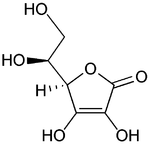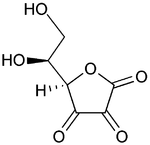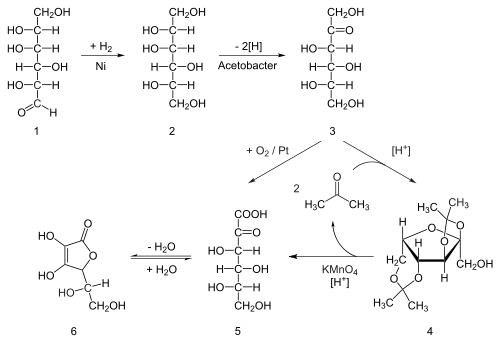- Ascorbic acid
-
This article is about the molecular aspects of ascorbic acid. For information about its role in nutrition, see Vitamin C.
L-Ascorbic acid 
 (5R)-[(1S)-1,2-dihydroxyethyl]-3,4-dihydroxyfuran-2(5H)-oneOther namesVitamin C
(5R)-[(1S)-1,2-dihydroxyethyl]-3,4-dihydroxyfuran-2(5H)-oneOther namesVitamin CIdentifiers CAS number 50-81-7 
PubChem 5785 ChemSpider 10189562 
UNII PQ6CK8PD0R 
EC number 200-066-2 KEGG D00018 
ChEBI CHEBI:29073 
ChEMBL CHEMBL196 
ATC code A11 Jmol-3D images Image 1
Image 2- OC=1C(OC(=O)C=1O)[C@@H](O)CO
C([C@@H]([C@@H]1C(=C(C(=O)O1)O)O)O)O
- InChI=1S/C6H8O6/c7-1-2(8)5-3(9)4(10)6(11)12-5/h2,5,7-10H,1H2/t2-,5+/m0/s1

Key: CIWBSHSKHKDKBQ-JLAZNSOCSA-N
InChI=1/C6H8O6/c7-1-2(8)5-3(9)4(10)6(11)12-5/h2,5,7-10H,1H2/t2-,5?/m0/s1
Key: CIWBSHSKHKDKBQ-SZSCBOSDBY
InChI=1/C6H8O6/c7-1-2(8)5-3(9)4(10)6(11)12-5/h2,5,7-10H,1H2/t2-,5+/m0/s1
Key: CIWBSHSKHKDKBQ-JLAZNSOCBT
Properties Molecular formula C6H8O6 Molar mass 176.12 g mol−1 Appearance White or light yellow solid Density 1.65 g/cm3 Melting point 190-192 °C, 463-465 K, 374-378 °F (decomp.)
Solubility in water 33 g/100 mL Solubility in ethanol 2 g/100 mL Solubility in glycerol 1 g/100 mL Solubility in propylene glycol 5 g/100 mL Solubility in other solvents insoluble in diethyl ether, chloroform, benzene, petroleum ether, oils, fats Acidity (pKa) 4.10 (first), 11.6 (second) Hazards MSDS JT Baker
Oxford UniversityLD50 11.9 g/kg (oral, rat)[1]  acid (verify) (what is:
acid (verify) (what is:  /
/ ?)
?)
Except where noted otherwise, data are given for materials in their standard state (at 25 °C, 100 kPa)Infobox references Ascorbic acid is a naturally occurring organic compound with antioxidant properties. It is a white solid, but impure samples can appear yellowish. It dissolves well in water to give mildly acidic solutions. Ascorbic acid is one form ("vitamer") of vitamin C. The name is derived from a- (meaning "no") and scorbutus (scurvy), the disease caused by a deficiency of vitamin C. Being derived from glucose, many animals are able to produce it, but humans require it as part of their nutrition. Whereas most vertebrates can produce ascorbic acid, some groups such as primates —including humans—, guinea pigs, teleost fishes, bats and birds cannot and require it as a dietary micronutrient (that is, a vitamin).[2]
Contents
History
From the middle of the 18th century, it was noted that lemon juice could prevent the sailors from getting scurvy. At first it was supposed that the acid properties were responsible for this benefit; however, it soon became clear that other dietary acids, such as vinegar, had no benefits. In 1907, two Norwegian physicians reported an essential disease-preventing compound in foods that was distinct from the one that prevented Beriberi. The physicians were investigating dietary deficiency diseases using the new animal model of guinea pigs, which are susceptible to scurvy. The newly discovered food-factor was eventually called vitamin C.
From 1928 to 1932, the Hungarian research team led by Albert Szent-Györgyi, as well as that of the American worker Charles Glen King, identified the antiscorbutic factor as a particular single chemical substance. At the Mayo clinic, Szent-Györgyi had isolated the chemical hexuronic acid from animal adrenal glands. He suspected it to be the antiscorbutic factor, but could not prove it without a biological assay. This assay was finally conducted at the University of Pittsburgh in the laboratory of King, which had been working on the problem for years. In late 1931, King's lab obtained adrenal hexuronic acid indirectly from Szent-Györgyi and proved that it is vitamin C by early 1932. This was the last of the compound from animal sources, but, later that year, Szent-Györgyi's group discovered that paprika pepper, a common spice in the Hungarian diet, is a rich source of hexuronic acid, so he sent some of the now-more-available chemical to Walter Norman Haworth, a British sugar chemist.[3] In 1933, working with the then-Assistant Director of Research (later Sir) Edmund Hirst and their research teams, Haworth deduced the correct structure and optical-isomeric nature of vitamin C, and in 1934 reported the first synthesis of the vitamin.[4] In honor of the compound's antiscorbutic properties, Haworth and Szent-Györgyi now proposed the new name of "a-scorbic acid" for the compound. It was named L-ascorbic acid by Haworth and Szent-Györgyi when its structure was finally proven by synthesis.[5]
In 1937, the Nobel Prize for chemistry was awarded to Norman Haworth for his work in determining the structure of ascorbic acid (shared with Paul Karrer, who received his award for work on vitamins), and the prize for Physiology or Medicine that year went to Albert Szent-Györgyi for his studies of the biological functions of L-ascorbic acid. The American physician Fred R. Klenner M.D. promoted vitamin C as a cure for many diseases in the 1950s by elevating the dosages largely. Tens of grams vitamin C daily by injections were no exception. From 1967 on, Nobel prize winner Linus Pauling recommended high doses of ascorbic acid (he himself took 18 grams daily) as a prevention against cold and cancer. The results of Klenner have been controversial as yet, since his investigations do not meet the modern methodologic standards.[6]
Reactions
Ascorbic acid resembles the sugar from which it is derived, being a ring containing many oxygen-containing functional groups. The molecule exists in equilibrium with two ketone tautomers, which are less stable than the enol form.[citation needed] In solutions, these forms of ascorbic acid rapidly interconvert.
 Nucleophilic attack of ascorbic enol on proton to give 1,3-diketone
Nucleophilic attack of ascorbic enol on proton to give 1,3-diketoneAntioxidant mechanism
As a mild reducing agent, ascorbic acid degrades upon exposure to air, converting the oxygen to water. The redox reaction is accelerated by the presence of metal ions and light. It can be oxidized by one electron to a radical state or doubly oxidized to the stable form called dehydroascorbic acid.

 Top: ascorbic acid
Top: ascorbic acid
(reduced form of Vitamin C)
Bottom: dehydroascorbic acid
(nominal oxidized form of Vitamin C)Ascorbate usually acts as an antioxidant. It typically reacts with oxidants of the reactive oxygen species, such as the hydroxyl radical formed from hydrogen peroxide. Such radicals are damaging to animals and plants at the molecular level due to their possible interaction with nucleic acids, proteins, and lipids. Sometimes these radicals initiate chain reactions. Ascorbate can terminate these chain radical reactions by electron transfer. Ascorbic acid is special because it can transfer a single electron, owing to the stability of its own radical ion called "semidehydroascorbate". dehydroascorbate. The net reaction is:
- RO• + C6H7O−
6 → ROH + C6H6O6-•.
The oxidized forms of ascorbate are relatively unreactive, and do not cause cellular damage.
However, being a good electron donor, excess ascorbate in the presence of free metal ions can not only promote but also initiate free radical reactions, thus making it a potentially dangerous pro-oxidative compound in certain metabolic contexts.
Acidity
Ascorbic acid, a reductone, behaves as a vinylogous carboxylic acid wherein the electrons in the double bond, hydroxyl group lone pair, and the carbonyl double bond form a conjugated system. Because the two major resonance structures stabilize the deprotonated conjugate base of ascorbic acid, the hydroxyl group in ascorbic acid is much more acidic than typical hydroxyl groups. In other words, ascorbic acid can be considered an enol in which the deprotonated form is a stabilized enolate.
Food chemistry
Ascorbic acid and its sodium, potassium, and calcium salts are commonly used as antioxidant food additives. These compounds are water-soluble and thus cannot protect fats from oxidation: For this purpose, the fat-soluble esters of ascorbic acid with long-chain fatty acids (ascorbyl palmitate or ascorbyl stearate) can be used as food antioxidants. Eighty percent of the world's supply of ascorbic acid is produced in China.[7]
The relevant European food additive E numbers are
- E300 ascorbic acid (approved for use as a food additive in the EU[8], USA[9] and Australia and New Zealand)[10]
- E301 sodium ascorbate(approved for use as a food additive in the EU[11], USA[12] and Australia and New Zealand)[13]
- E302 calcium ascorbate(approved for use as a food additive in the EU[14], USA[15] and Australia and New Zealand)[16]
- E303 potassium ascorbate
- E304 fatty acid esters of ascorbic acid (i) ascorbyl palmitate (ii) ascorbyl stearate.
In plastic manufacturing, ascorbic acid can be used to assemble molecular chains more quickly and with less waste than traditional synthesis methods.[17]
It creates volatile compounds when mixed with glucose and amino acids.[18]
It is a cofactor in tyrosine oxidation.[19]
Niche, non-food uses
Ascorbic acid is easily oxidized and so is used as a reductant in photographic developer solutions (among others) and as a preservative.
In fluorescence microscopy and related fluorescence-based techniques, ascorbic acid can be used as an antioxidant to increase fluorescent signal and chemically retard dye photobleaching.[20]
It is also commonly used to remove dissolved metal stains, such as iron, from fiberglass swimming pool surfaces.
Biosynthesis
Main article: Vitamin CAscorbic acid is found in plants, animals, and single-cell organisms where it is produced from glucose.[21] All animals either make it, eat it, or else die from scurvy due to lack of it. Reptiles and older orders of birds make ascorbic acid in their kidneys. Recent orders of birds and most mammals make ascorbic acid in their liver where the enzyme L-gulonolactone oxidase is required to convert glucose to ascorbic acid.[21] Humans, some other primates, and guinea pigs are not able to make L-gulonolactone oxidase because of a genetic mutation and are therefore unable to make ascorbic acid. Synthesis and signalling properties are still under investigation.[22]
Industrial preparation
Ascorbic acid is prepared industrially from glucose in a method based on the historical Reichstein process. In the first of a five-step process, glucose is catalytically hydrogenated to sorbitol, which is then oxidized by the microorganism Acetobacter suboxydans to sorbose. Only one of the six hydroxy groups is oxidized by this enzymatic reaction. From this point, two routes are available. Treatment of the product with acetone in the presence of an acid catalyst converts four of the remaining hydroxyl groups to acetals. The unprotected hydroxyl group is oxidized to the carboxylic acid by reaction with the catalytic oxidant TEMPO (regenerated by sodium hypochlorite &emdash; bleaching solution). (Historically, industrial preparation via the Reichstein process used potassium permanganate.) Acid-catalyzed hydrolysis of this product performs the dual function of removing the two acetal groups and ring-closing lactonization. This step yields ascorbic acid. Each of the five steps has a yield larger than 90%.[23]
A more biotechnological process, first developed in China in the 1960s but further developed in the 1990s, bypasses the use of acetone protecting groups. A second genetically-modified microbe species (such as mutant Erwinia, among others) oxidises sorbose into 2-ketogluconic acid (2-KGA), which can then undergo ring-closing lactonization via dehydration. This method is used in the predominant process used by the ascorbic acid industry in China, which supplies 80% of world's ascorbic acid.[24] American and Chinese researchers are competing to engineer a mutant which can carry out a one-pot fermentation directly from glucose to 2-KGA, bypassing both the need for a second fermentation and the need to reduce glucose to sorbitol. [25]
Determination
The traditional way to analyze the ascorbic acid content is titration with an oxidizing agent, and several procedures have been developed, mainly relying on iodometry. Iodine is used in the presence of a starch indicator. Iodine is reduced by ascorbic acid, and, when all the ascorbic acid has reacted, the iodine is then in excess, forming a blue-black complex with the starch indicator. This indicates the end-point of the titration. As an alternative, ascorbic acid can be treated with iodine in excess, followed by back titration with sodium thiosulfate using starch as an indicator.[26] The preceding iodometric method has been revised to exploit reaction of ascorbic acid with iodate and iodide in acid solution. Electrolyzing the solution of potassium iodide produces iodine, which reacts with ascorbic acid. The end of process is determined by potentiometric titration in a manner similar to Karl Fischer titration. The amount of ascorbic acid can be calculated by the Faraday's law.
An uncommon oxidising agent is N-bromosuccinimide, (NBS). In this titration, the NBS oxidises the ascorbic acid in the presence of potassium iodide and starch. When the NBS is in excess (i.e., the reaction is complete), the NBS liberates the iodine from the potassium iodide, which then forms the blue-black complex with starch, indicating the end-point of the titration.
Compendial status
- British Pharmacopoeia[27]
- Japanese Pharmacopoeia [28][clarification needed]
See also
- Colour retention agent
- Vitamin C: a discussion of the medical properties of ascorbic acid as well as its historic and social role
- Dehydroascorbic acid, an oxidized form of ascorbic acid.
- Erythorbic acid: a diastereomer of ascorbic acid.
- Mineral ascorbates: salts of ascorbic acid
- D-erythroascorbic acid: yeasts do not make vitamin C (L-ascorbic acid) but a similar antioxidant known as D-erythroascorbic acid
- Acids in wine
Notes and references
- ^ "Safety (MSDS) data for ascorbic acid". Oxford University. 2005-10-09. http://physchem.ox.ac.uk/MSDS/AS/ascorbic_acid.html. Retrieved 2007-02-21.
- ^ Lachapelle, M. Y.; Drouin, G. (2010). "Inactivation dates of the human and guinea pig vitamin C genes". Genetica 139 (2): 199–207. doi:10.1007/s10709-010-9537-x. PMID 21140195.
- ^ Story of Vitamin C's chemical discovery. Accessed Jan 21, 2010
- ^ Davies, Michael B.; Austin, John; Partridge, David A. (1991), Vitamin C: Its Chemistry and Biochemistry, The Royal Society of Chemistry, p. 48, ISBN 0-85186-333-7
- ^ Svirbelf, Joseph Louis; Szent-Györgyi, Albert (April 25, 1932), The Chemical Nature Of Vitamin C, http://profiles.nlm.nih.gov/WG/B/B/G/W/_/wgbbgw.pdf. Part of the National Library of Medicine collection. Accessed January 2007
- ^ The American physician Thomas E Levy, M.D. J.D. wrote a critical review about Klenner's work, Curing the Incurable, LiveOn Books 2002, 3rd edition 2009, ISBN 0-9779-5202-9.
- ^ Weiss, Rick (May 20, 2007), "Tainted Chinese Imports Common", Washington Post, http://www.washingtonpost.com/wp-dyn/content/article/2007/05/19/AR2007051901273.html, retrieved 2010-04-25.
- ^ UK Food Standards Agency: "Current EU approved additives and their E Numbers". http://www.food.gov.uk/safereating/chemsafe/additivesbranch/enumberlist. Retrieved 2011-10-27.
- ^ US Food and Drug Administration: "Listing of Food Additives Status Part I". http://www.fda.gov/Food/FoodIngredientsPackaging/FoodAdditives/FoodAdditiveListings/ucm091048.htm. Retrieved 2011-10-27.
- ^ Australia New Zealand Food Standards Code"Standard 1.2.4 - Labelling of ingredients". http://www.comlaw.gov.au/Details/F2011C00827. Retrieved 2011-10-27.
- ^ UK Food Standards Agency: "Current EU approved additives and their E Numbers". http://www.food.gov.uk/safereating/chemsafe/additivesbranch/enumberlist. Retrieved 2011-10-27.
- ^ US Food and Drug Administration: "Listing of Food Additives Status Part II". http://www.fda.gov/Food/FoodIngredientsPackaging/FoodAdditives/ucm191033.htm#ftnT. Retrieved 2011-10-27.
- ^ Australia New Zealand Food Standards Code"Standard 1.2.4 - Labelling of ingredients". http://www.comlaw.gov.au/Details/F2011C00827. Retrieved 2011-10-27.
- ^ UK Food Standards Agency: "Current EU approved additives and their E Numbers". http://www.food.gov.uk/safereating/chemsafe/additivesbranch/enumberlist. Retrieved 2011-10-27.
- ^ US Food and Drug Administration: "Listing of Food Additives Status Part I". http://www.fda.gov/Food/FoodIngredientsPackaging/FoodAdditives/FoodAdditiveListings/ucm091048.htm. Retrieved 2011-10-27.
- ^ Australia New Zealand Food Standards Code"Standard 1.2.4 - Labelling of ingredients". http://www.comlaw.gov.au/Details/F2011C00827. Retrieved 2011-10-27.
- ^ Vitamin C, water have benefits for plastic manufacturing, Reliable Plant Magazine, 2007, archived from the original on 2007-09-27, http://web.archive.org/web/20070927230356/http://www.reliableplant.com/article.asp?pagetitle=Vitamin+C,+water+have+benefits+for+plastic+manufacturing&articleid=3133, retrieved 2007-06-25.
- ^ http://onlinelibrary.wiley.com/doi/10.1111/j.1365-2621.1981.tb15349.x/abstract
- ^ http://www.jbc.org/content/196/2/761.full.pdf
- ^ Jerker Widengren, Andriy Chmyrov, Christian Eggeling, Per-Åke Löfdahl, and Claus A. M. Seidel (2007), "Strategies to Improve Photostabilities in Ultrasensitive Fluorescence Spectroscopy", The Journal of Physical Chemistry A 111 (3): 429–440, doi:10.1021/jp0646325, PMID 17228891.
- ^ a b Stone, Irwin (1972), The Natural History of Ascorbic Acid in the Evolution of Mammals and Primates, http://www.seanet.com/~alexs/ascorbate/197x/stone-i-orthomol_psych-1972-v1-n2-3-p82.htm.
- ^ Valpuesta, Victoriano; Botella, Miguel (December 2004), "Biosynthesis of L-ascorbic acid in plants: new pathways for an old antioxidant", TRENDS in Plant Science 9 (12), http://www.bmbq.uma.es/lbbv/index_archivos/pdf/Valpuesta%202004.pdf
- ^ Manfred Eggersdorfer et al. "Vitamins" in Ullmann's Encylopedia of Industrial Chemistry 2005, Wiley-VCH, Weinheim. doi:10.1002/14356007.a27_443
- ^ http://www.csmonitor.com/2007/0720/p01s01-woap.html
- ^ http://www.competition-commission.org.uk/rep_pub/reports/2001/fulltext/456a5.1.pdf
- ^ A website with an excerpt to using iodine
- ^ British Pharmacopoeia Commission Secretariat (2009). "Index, BP 2009". http://www.pharmacopoeia.co.uk/pdf/2009_index.pdf. Retrieved 4 February 2010.
- ^ "Japanese Pharmacopoeia, Fifteenth Edition". 2006. http://jpdb.nihs.go.jp/jp15e/JP15.pdf. Retrieved 4 Februally 2010.
Further reading
- Clayden; Greeves; Warren; Wothers (2001), Organic Chemistry, Oxford University Press, ISBN 0-19-850346-6.
- Davies, Michael B.; Austin, John; Partridge, David A., Vitamin C: Its Chemistry and Biochemistry, Royal Society of Chemistry, ISBN 0-85186-333-7.
- Coultate, T. P., Food: The Chemistry of Its Components (3rd ed.), Royal Society of Chemistry, ISBN 0-85404-513-9.
- Gruenwald, J.; Brendler, T.; Jaenicke, C., eds. (2004), PDR for Herbal Medicines (3rd ed.), Montvale, New Jersey: Thomson PDR.
- McMurry, John (2008), Organic Chemistry (7e ed.), Thomson Learning, ISBN 978-0-495-11628-8.
External links
- International Chemical Safety Card 0379
- SIDS Initial Assessment Report for L-Ascorbic acid from the Organisation for Economic Co-operation and Development (OECD)
- IPCS Poisons Information Monograph (PIM) 046
- Interactive 3D-structure of vitamin C with details on the x-ray structure
Vitamins (A11) Fat soluble D2 (Ergosterol, Ergocalciferol#) · D3 (7-Dehydrocholesterol, Previtamin D3, Cholecalciferol, 25-hydroxycholecalciferol, Calcitriol (1,25-dihydroxycholecalciferol), Calcitroic acid) · D4 (Dihydroergocalciferol) · D5 · D analogues (Dihydrotachysterol, Calcipotriol, Tacalcitol, Paricalcitol)Water soluble B1 (Thiamine#) · B2 (Riboflavin#) · B3 (Niacin, Nicotinamide#) · B5 (Pantothenic acid, Dexpanthenol, Pantethine) · B6 (Pyridoxine#, Pyridoxal phosphate, Pyridoxamine) · B7 (Biotin) · B9 (Folic acid, Dihydrofolic acid, Folinic acid) · B12 (Cyanocobalamin, Hydroxocobalamin, Methylcobalamin, Cobamamide) · CholineAscorbic acid# · Dehydroascorbic acidCombinations M: NUT
cof, enz, met
noco, nuvi, sysi/epon, met
drug(A8/11/12)
Enzyme cofactors Active forms TPP / ThDP (B1) · FMN, FAD (B2) · NAD+, NADH, NADP+, NADPH (B3) · Coenzyme A (B5) · PLP / P5P (B6) · Biotin (B7) · THFA / H4FA, DHFA / H2FA, MTHF (B9) · AdoCbl, MeCbl (B12) · Ascorbic Acid (C) · Phylloquinone (K1), Menaquinone (K2) · Coenzyme F420ATP · CTP · SAMe · PAPS · GSH · Coenzyme B · Cofactor F430 · Coenzyme M · Coenzyme Q · Heme / Haem (A, B, C, O) · Lipoic Acid · Methanofuran · Molybdopterin/Molybdenum cofactor · PQQ · THB / BH4 · THMPT / H4MPTBase forms vitamins: see vitaminsM: NUT
cof, enz, met
noco, nuvi, sysi/epon, met
drug(A8/11/12)
Antioxidants Acetyl-L-Carnitine (ALCAR) • Alpha-Lipoic Acid (ALA) • Ascorbic Acid (Vitamin C) • Carotenoids (Vitamin A) • Curcumin • Edaravone • Polyphenols • Glutathione • Hydroxytyrosol • L-Carnitine • Ladostigil • Melatonin • N-Acetylcysteine (NAC) • N-Acetylserotonin (NAS) • Oleocanthal • Oleuropein • Rasagiline • Resveratrol • Selegiline • Selenium • Tocopherols (Vitamin E) • Tocotrienols (Vitamin E) • Tyrosol • Ubiquinone (Coenzyme Q) • Uric AcidCategories:- Organic acids
- Antioxidants
- Dietary antioxidants
- Coenzymes
- Corrosion inhibitors
- Furones
- Vitamers
- Vitamin C
- OC=1C(OC(=O)C=1O)[C@@H](O)CO
Wikimedia Foundation. 2010.


